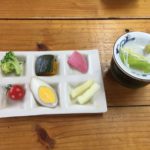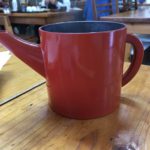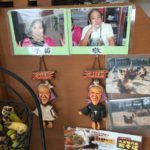蕎麦 soba: buckwheat, or buckwheat noodles. This is the type of soba common in the mainland of Japan, not the kind used for Okinawa suba (soba).
Did you know that in the northern part of Okinawa, in Ogimi village 大宜味村, buckwheat (soba 蕎麦) grows? There are 3 restaurants that serve Japanese-style soba noodles made from Ogimi village buckwheat flour.
江州の花 “Esu no Hana” is one of these restaurants that make the noodles by hand (one other is at the roadside station and another is a shokudo restaurant just north of the roadside station). Japanese mainland soba is not as popular here as Okinawa soba is, so I was very surprised to learn this. Since I am slightly (mainland) soba obsessed, I decided I must try it!
So we set out for a drive up north, and of course after exiting the main road had to drive up and down some twisty roads to find the place as it was pretty much in the middle of nowhere. We arrived at exactly 11am and there was already another car there with people waiting to get in; it said somewhere online that reservations were a good idea, and although we did not make any, we were luckily able to be seated. There were 6 decently large tables inside. They were happy when they realized I could speak/read Japanese– we figured out a bit later that this not a place for tourists, but definitely for locals! If you plan on going during busy days (holidays, Sundays, summer vacation, etc), I would definitely recommend getting a reservation. The place was packed by the time we left, all with locals and not a rental car to be seen.
The menu is very easy, so not to worry! Here is the translation:
- soba set, regular: 1000yen
- soba set, large: 1500yen
- udon set kids/regular/large: 500/700/800yen
- omakaze set (comes with both udon and soba): 1500yen
Everything on the menu also comes with:
- “appetizer” (which is basically various tsukemono/pickles)
- agedashi tofu (fried tofu with sauce)
- bonito/katsuobushi soup (winter) or salad (summer)
- endless tempura!
As for drinks, tea and water were included on the tables. The large soba set comes with about twice the amount of noodles as the regular. I did not see anyone order the udon sets, I think if you come up to Ogimi, you should try the locally grown, ground, and handmade soba, and not bother with udon unless you have a picky eater in your group.
We just stuck with soba set regular size. The picture showed just a set that comes out, so we were expecting something pretty simple like the typical teishoku 定食 meals. Instead, we were greeted with quite the feast!
First, we were immediately brought out a small plate 6 “appetizers” 前菜 and the soba dipping broth was placed out as well. Moments later, we were brought out katsuobushi かつお節 (dried, smoked bonito flakes) with hot water poured over. We were told to stir the katsuobushi in the hot water and kind of let it steep to get out the flavor. A bit later we were presented with agedashi tofu 揚げ出し豆腐, although I admit I have never had it quite like this before… but it was very delicious. I was surprised by the amount of “sauce” that came with it… we learned just a few minutes later that it is also used as the tempura dipping sauce. Needless to say, this was shaping up to be quite an interesting experience.
The first of the fresh, piping hot tempura was brought out to us, along with our soba plates. As we were happily eating, a second different type of tempura came out. We thought this was it, until again, another batch of fresh and different tempura arrived! This kept going and going, with some unique and delicious tempura! Most days they serve up to 12 types of fresh and tasty tempura, all included in your lunch price! It was pretty much all you could eat tempura… we probably could have stayed for longer (and eaten even more), as they were not shoo-ing us out the door all.
After we finished our soba, some soba-yu 蕎麦湯 also came out to finish our soba broth with. At this point, we were absolutely stuffed full, and what a value for only 1000yen. If you cannot finish it all, they even had some takeout containers (which I noticed some obaasans that came about the same time as us utilized). Actually, they will even encourage you to take some tempura home with you.
What struck me most about the whole experiences was just how really great and friendly the service was, and the atmosphere was like being at your grandma or aunty’s house! Of course, us being foreigners, owners and customers alike were especially interested in where we were from, where we lived, and one lady said I was practically a Japanese person (lol). Apparently there was also some Okinawa dance at the community center later that they invited us to, but we already had some things on the schedule. This being said, the wife came out to greet every single customer who entered, and asked the non-village residents where they were from. It really reminded me of the innate friendliness of the Okinawan people. Anyway, I highly recommend visiting this place as it is an experience you will likely never forget!
*Something new I learned it that residents in Ogimi are the renown for longevity– some of the longest life-spans in the world!
address: 沖縄県大宜味村大保326-224
https://goo.gl/maps/Ng2bZbbzb7z
*Open 11-6, closed on Wednesdays.












